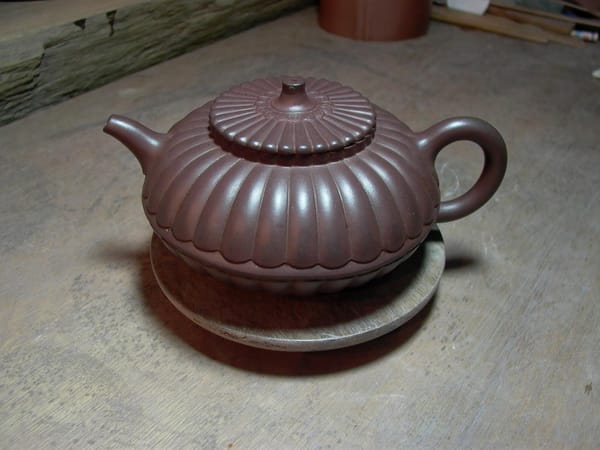Looking to buy a Zisha (Purple Clay) teapot but worried about fakes? The authenticity of the clay directly impacts tea quality and your teapot's lifespan. This guide will show you how to spot genuine Zisha clay using your eyes, hands, and simple tests to avoid market pitfalls and find your perfect teapot.
Whenever friends ask me about teapots, I always tell them the same thing: learning to identify authentic Zisha clay is your crucial first step. It's like checking a house's foundation—no matter how beautiful the exterior, without a solid foundation, you'll never have a good home.
What Makes Real Zisha Clay Special?
I remember being confused when first hearing about Zisha clay's "double-sphere structure." It sounded like complex scientific jargon, but this feature is actually the key to what makes these teapots so remarkable.
This unique structure gives Zisha clay exceptional breathability. When tea meets the pot wall, water molecules can subtly penetrate the surface, giving the brew a distinctive "breathing quality." This natural process softens the tannins in tea, creating a more rounded, harmonious flavor.
An experienced tea friend once showed me a simple yet revealing test: he brewed identical tea in two similar-looking pots—one made from pure mineral Zisha and another containing chemical additives. After letting both sit for a day, the difference was striking. The tea in the authentic pot still smelled fresh, while the one in the fake pot had turned sour and spoiled! This effect is thanks to the clay itself—not magic.
How to Spot Fake Zisha Teapots at a Glance
Counterfeit Zisha teapots typically share several telltale signs. Once you know what to look for, spotting fakes becomes much easier.
Watch for these red flags:
- Unnaturally glossy surface (what experts call "suspicious sheen"): Authentic Zisha has a subtle luster, while fakes often have an excessive, artificial shine that catches the eye too easily.
- Strange smell: Real Zisha teapots should be nearly odorless or have just a faint earthy scent. If you detect plastic, chemicals, or any strong odor, walk away.
- Suspiciously low price: Quality Zisha clay is expensive. If a deal seems too good to be true, it probably is.
- Unnatural feel: Authentic pots have a distinctive texture—slightly rough yet pleasant to touch. Fakes often feel too smooth, cold, or plastic-like.
By contrast, genuine Zisha teapots display what craftsmen call "water luster"—a subtle, deep glow that emerges naturally after proper firing. It's understated yet captivating, revealing the clay's inner character rather than shouting for attention.
Like a person's true character, authentic beauty doesn't need to be flashy. The most eye-catching teapots are often the least authentic.
Why Authentic Zisha Clay Is So Valuable
The value of genuine Zisha clay starts with its limited source. The famous clay mines in Yixing, particularly the renowned No. 4 mine, have been closed due to flooding. Today's high-quality clay comes mostly from previously mined inventory that has been aging for years.
Zisha clay is valued like gold in the teaware world. Similar to fine wine, quality Zisha clay improves with age, developing unique properties that make it ideal for crafting exceptional teapots. This explains why artisans so carefully preserve their clay reserves.
Creating premium Zisha clay involves a meticulous process: selection, grinding, sieving, iron removal, washing, blending, and vacuum treatment. Each step is essential for ensuring the clay's quality and performance.
4 Practical Tips to Avoid Buying Fake Zisha Teapots
Here's how to protect yourself when shopping for a Zisha teapot:
- Look for subtle luster, not shine: Authentic Zisha has a gentle, natural glow rather than a flashy shine. Be wary of any new pot with an unusually glossy appearance.
- Try the overnight tea test: If possible, brew tea in the pot and let it sit for a day. Tea in genuine Zisha remains fresh longer, while tea in fake pots quickly sours.
- Check heat transfer: Pour warm water into the pot and feel how the heat moves through the wall. Real Zisha conducts heat gradually and evenly—a sign of proper breathability.
- Connect with experienced collectors: Join tea communities and learn from those who've developed an eye for authentic teapots. Their guidance can save you from costly mistakes.
The True Value of an Authentic Zisha Teapot
A genuine Zisha teapot is more than just a brewing vessel—it's a bridge connecting you, your tea, and nature itself. When you hold an authentic Zisha teapot, you're holding centuries of craftsmanship and a remarkable natural material.
Zisha teapots let tea breathe, bringing out its true character, just as we ourselves thrive in environments where we can be authentic. The patina that develops on a well-used Zisha pot tells a story—your story with tea, written over time.
Perhaps there's a life lesson in choosing teapots: genuine beauty comes from authenticity, not superficial polish or artificial enhancement.
Next time you examine a Zisha teapot, take a moment to feel its texture and observe its subtle luster. This simple act is your first defense against fakes and the beginning of a deeper appreciation for the art of Zisha.
FAQ: What Every Zisha Beginner Should Know
Q: With such wide price variations, how can I tell what's reasonable?
A: Genuine hand-crafted Zisha teapots are never cheap. Their price reflects both the scarcity of quality clay and the artisan's skill. Be especially cautious of machine-made or chemically-enhanced pots with suspiciously low prices.
Q: Do all Zisha teapots need "seasoning"?
A: Yes. The seasoning process allows the clay to interact with tea over time, developing a beautiful patina and enhancing brewing performance. Fake pots rarely develop this natural transformation. According to Teatasting.net, properly seasoned pots can significantly improve tea flavor.
Q: How can I tell Yixing Zisha clay from other similar clays?
A: Yixing Zisha has a unique mineral composition that gives it superior breathability. For beginners, the safest approach is to consult experienced collectors or reputable dealers, as visual identification takes years of experience.
Q: What style should beginners start with?
A: Start with classic shapes like Xi Shi (西施) or Shi Piao (石瓢) pots in a moderate size (about 150-200ml). Focus first on finding authentic clay rather than chasing famous artisans' signatures.
Whether you're just discovering Zisha teapots or looking to add to your collection, recognizing authentic clay is your foundation for a rewarding tea journey. The right teapot becomes not just a brewing vessel, but a trusted companion for countless peaceful tea sessions to come.


